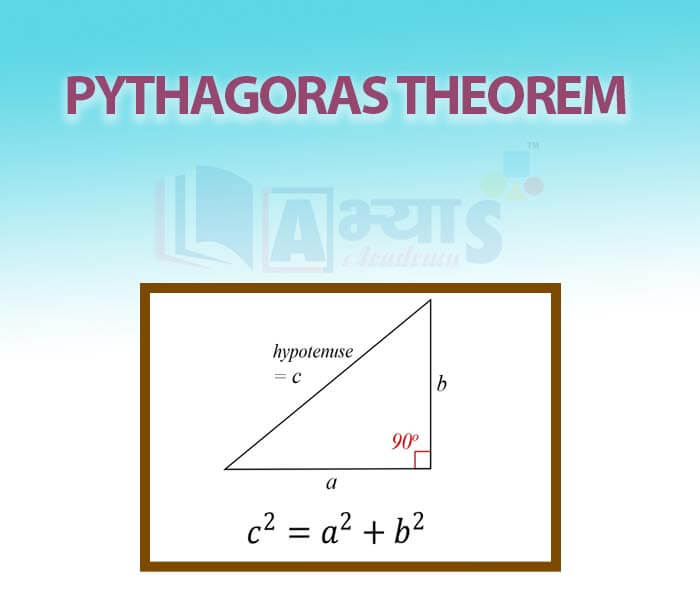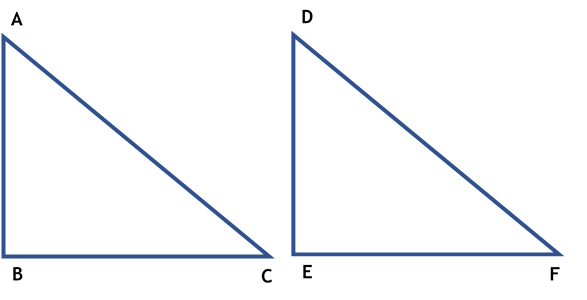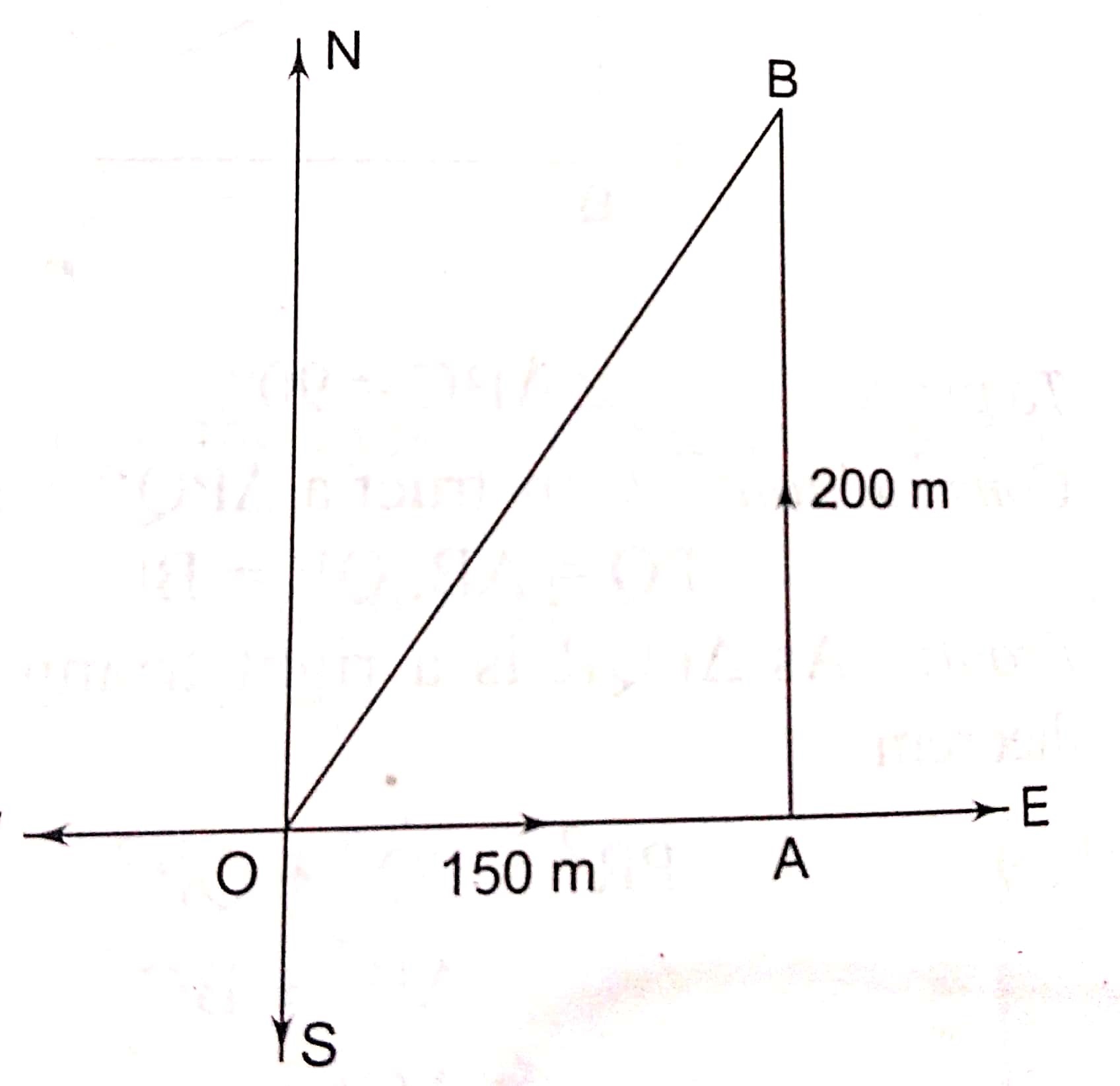Pythagoras Theorem










Pythagoras Theorem
Pythagoras Theorem:
Pythagoras, the famous Greek philosopher, lived about 572 B.C. to 501 B.C. He proved the relation between the lengths of the sides of a triangle, Although, this theorem was known to the Babylonians 1000 years ealier, but, Pythagoras is believed to have the first to discovered a proof of this theorem. However, long ago ( 800 B.C.), the Indian mathe,atician Baudhaya had stated and proved this property of a right angled triangle.
Let us have a look at the fig. is a right triangle, right angled at C, so that AB is the hypotenuse and AC and BC are the sides of the right triangle,
Then,
i.e.,
Given: A triangle ABC right angled at B To Prove: Construction: From B draw BD Proof: Since BD
Now
Adding Eq (1) and (2) Hence Proved |
|
Example 1: The lengths of two sides of a right triangle are 5 cm and 12 cm. Find the length of the hypotenuse.
Solution: Suppose BC = 5cm and AC = 12 cm.
By Pythagoras theorem,
Length of the hypotenuse = 13 cm.
Converse of Pythagoras Theorem:
THeorem: In a triangle if the square of one side is equal to the sum of squares of the other two sides, then the angle opposite to the first side is a right angle.
Given: A triangle ABC such that To Prove : Construction : Construct a triangle DEF such that DE= AB, EF= BC and Proof: Since Since DE = AB and EF = BC replacing them in the above equation But DF = AC Now in AB = DE [By Construction] BC= EF [By Construction ] DF = AC [Proved Above]
Hence |  |
Illustration: ABC is an isosceles triangle with Ac = BC. If . Prove that ABC is aright triangle.
In AC = BC and Now Adding But From Converse of Pythagoras Theorem we can say that Triangle ABC is a right angled at C |  |
The length of the hypotenuse of a right triangle exceeds the length of the base by 2 cm and exceeds twice the length of the altitude by 1 cm. Find the length of each side of the triangle. | |||
| Right Option : C | |||
| View Explanation | |||
A man goes 150 m due east and then 200 m due north. How far is he from the starting point?
| |||
| Right Option : B | |||
| View Explanation | |||
If square of one side of triangle is equal to the sum of the square of other two sides then triangle is ______________________. | |||
| Right Option : C | |||
| View Explanation | |||
Students / Parents Reviews [20]
Third consective year,my ward is in Abhyas with nice experience of admin and transport support.Educational standard of the institute recumbent at satisfactory level. One thing would live to bring in notice that last year study books was distributed after half of the session was over,though study ...

Ayan Ghosh
8thAbout Abhyas metholodology the teachers are very nice and hardworking toward students.The Centre Head Mrs Anu Sethi is also a brilliant teacher.Abhyas has taught me how to overcome problems and has always taken my doubts and suppoeted me.

Shreya Shrivastava
8thIt has a great methodology. Students here can get analysis to their test quickly.We can learn easily through PPTs and the testing methods are good. We know that where we have to practice

Barkha Arora
10thMy experience was very good with Abhyas academy. I am studying here from 6th class and I am satisfied by its results in my life. I improved a lot here ahead of school syllabus.

Ayan Ghosh
8thI have spent a wonderful time in Abhyas academy. It has made my reasoning more apt, English more stronger and Maths an interesting subject for me. It has given me a habbit of self studying

Yatharthi Sharma
10thWe started with lot of hope that Abhyas will help in better understnding of complex topics of highers classes. we are not disappointed with the progress our child has made after attending Abhyas. Though need to mention that we expected a lot more. On a scale of 1-10, we would give may be 7.

Manya
8thOne of the best institutes to develope a child interest in studies.Provides SST and English knowledge also unlike other institutes. Teachers are co operative and friendly online tests andPPT develope practical knowledge also.

Aman Kumar Shrivastava
10thMy experience with Abhyas Academy has been very good. When I was not in Abhyas whenever teacher ask questions I could not speak it confidently but when I came in Abhyas, my speaking skills developed and now I am the first one to give the answer of teachers question.

Upmanyu Sharma
7thMy experience with Abhyas academy is very nice or it can be said wonderful. I have been studying here from seven class. I have been completing my journey of three years. I am tinking that I should join Abhyas Academy in tenth class as I am seeing much improvement in Maths and English

Hridey Preet
9thAbhyas is good institution and a innovative institute also. It is a good platform of beginners.Due to Abhyas,he has got knoweledge about reasoning and confidence.My son has improved his vocabulary because of Abhyas.Teacher have very friendly atmosphere also.

Manish Kumar
10thWhen I have not joined Abhyas Academy, my skills of solving maths problems were not clear. But, after joining it, my skills have been developed and my concepts of science and SST are very well. I also came to know about other subjects such as vedic maths and reasoning.

Sharandeep Singh
7thIt was good as the experience because as we had come here we had been improved in a such envirnment created here.Extra is taught which is beneficial for future.

Eshan Arora
8thAbhyas academy is great place to learn. I have learnt a lot here they have finished my fear of not answering.It has created a habit of self studying in me.The teachers here are very supportive and helpful. Earlier my maths and science was good but now it has been much better than before.

Barkha Arora
10thMy experience with Abhyas academy is very good. I did not think that my every subject coming here will be so strong. The main thing is that the online tests had made me learn here more things.

Hiya Gupta
8thAbhyas institute is one of the best coaching institute in the vicinity of Ambala Cantt area. The teachers of the institute are well experienced and very helpful in solving the problems of the students.The good thing of the institute is that it is providing extra classes for the students who are w...

Aman Kumar Shrivastava
10thMy experience with Abhyas is very good. I have learnt many things here like vedic maths and reasoning also. Teachers here first take our doubts and then there are assignments to verify our weak points.

Shivam Rana
7thUsually we see institutes offering objective based learning which usually causes a lag behind in subjective examinations which is the pattern followed by schools. I think it is really a work of planning to make us students grab the advantages of modes of examination, Objective Subjective and Onli...

Anika Saxena
8thBeing a parent, I saw my daughter improvement in her studies by seeing a good result in all day to day compititive exam TMO, NSO, IEO etc and as well as studies. I have got a fruitful result from my daughter.

Prisha Gupta
8thAbhyas Methodology is very good. It is based on according to student and each child manages accordingly to its properly. Methodology has improved the abilities of students to shine them in future.

Manish Kumar
10thThe experience was nice. I studied here for three years and saw a tremendous change in myself. I started liking subjects like English and SST which earlier I ran from. Extra knowledge gave me confidence to overcome competitive exams. One of the best institutes for secondary education.


